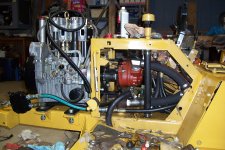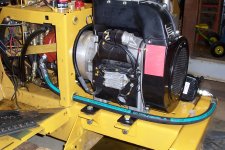Farmerford
Platinum Member
- Joined
- Dec 9, 2006
- Messages
- 733
- Location
- Columbus, Georgia
- Tractor
- Kuborta B2400, L2900, L4330; Caterpillar D3B, John Deere 455D
JD4310man:
I think the engine loading is caused by the flow divider. I assume priority flow is to the FEL valve. Assume your pump is producing 16 gpm and you have the flow divider set to provide an 8gpm priority flow to the loader valve. The flow divider sends the first 8gpm to the loader and the excess of 8gpm in this case to the other valve (you never said what that valve was, but I assume three point hitch; it doesn't really matter).
When the pump flow enters the flow divider it can take one of two paths: out the priority flow port or out the excess port. The flow divider works by forcing 8gpm to flow out of the priority flow port regardless of the pressure in that port; it does that by partially blocking the flow out of the excess port. If the FEL valve is in neutral there is very little pressure in the priority flow port because the only resistance to flow comes from losses inside the FEL valve, fittings, hoses, etc.; the spring loaded spool in the priority flow valve restricts the excess flow path only enough to cause 8gpm to flow through the priority port. But suppose you lift the FEL with a heavy load in the bucker that requires 500psig of pressure in the lift cylinders to move the load as fast as you want; that is the 8gpm of priority flow you want from the priority flow valve must over come 500psig of resistance in order to flow into the lift cylinder. The priority flow valve makes the 8gpm keep flowing out of the priority port, despite the fact that it now has to have at least 500psig of pressure, by restricting the flow in the excess port until it is also under 500psig of pressure. The spool in the priority flow valve shifts to partially block the excess flow port until the pressure in the excess flow port and priority flow port are the same; and the spring in the priority flow valve (that you adjusted) determines how much of the flow goes to the priority flow port when those pressures are equal.
Put simply, when you shift the loader valve to send fluid to the loader cylinders you increase the pressure in not only the loader circuit (the priority flow circuit), you also increase pressure to the same level in the excess flow circuit. In the above example, it is not only the 8gpm going to the FEL valve that requires 500psig pressure from the pump, it is also the 8gpm that is passing through the excess flow circuit. So, in your prior two pump set up you were only loading the FEL pump with 500psig when you worked the loader; now in effect you are loading "both" pumps.
Anything increasing the pressure in the priority flow circuit will aggravate the problem; fittings that are too small or with flow restrictors will increase the resistance in the FEL circuit and in turn increase the pressure in both the priority flow port and excess flow port.
The effect was most noticeable in regenerative mode on the bucket for two reasons. First, the nature of the regenerative circuit itself. The faster movement of the cylinder in regenerative comes from redirecting the exhaust flow from the cylinder from the tank to the other cylinder port. For example, if the cylinder to rod area ratio is such that the cylinder moves twice as fast, the cost is that it takes twice as much pump pressure to overcome resistance in the cylinder. Of course, when the bucket is being dumped and the load pulls it down rapidly, there is little if any resistance in the cylinder and and therefore little extra pressure on the pump. Second, your sticky cylinder increased the resistance even when dumping the cylinder to the point that the pump had to produce pressure to make it move. And it had to produce twice the normal pressure because of the regenerative feature. Of course, the effect of that increased pressured was reflected all the way back to the priority valve, which restricted the excess flow enough to raise the pressure on both the priority flow and excess flow enough to overcome the sticky cylinder.
You helped the problem when you turned down the priority flow because the reduced flow caused smaller pressure losses in the fittings, hoses, valve, etc. And I suspect you did not have a load in the bucket, so these flow losses were the primary source of pressure in the circuit; therefore even a small reduction in them would produce a noticeable result. If the bucket had a heavy load most of the pressure would have come from the load and any reduction in pressure due to lower flow would have been relatively very small and probably not noticeable.
The main effect (in addition to loading your engine more than necessary) is that the temperature of the hydraulic fluid will increase substantially during heavy work. The 8gpm flow through the priority curcuit is doing useful work by moving the cylinders. The additional 8gpm through the excess flow circuit is doing no useful work; it releases its energy by heating up the fluid as the pressure drops across the excess flow port. Temperature increases about 1 deg F for each 140psi of pressure drop. For example, suppose you have a heavy load in the loader that requires 2,000psig to lift. During that lift the priority flow valve, in order to keep the 8gpm you programmed (by adjusting the spring pressure) flowing through the priority flow circuit the priority valve spool shifts to block the excess flow just enough to keep the same 2,000psig pressure in the excess flow. But as soon as that excess flow leaves the priority valve its pressure drops to practically zero; thus that fluid has a 2,000psig pressure drop that does no useful work. The temperature of the fluid that flows through the excess circuit during the lift cycle increases by 1deg F for each 140psi of temperature drop. That means that fluid temperature increased by about 14deg F. To make the math easy, suppose the lift cycle lasted 7 seconds, which is about 1/8 minute; at 8gpm, one gallon of fluid passed through the excess flow circuit during the lift and its temperature was increased by 14 deg F.
The temperature increase in the hydraulic fluid volume as a whole will depend, of course, on the pressure drop which in turn depends on the load on the FEL, and on the length of time the loader works. We know nothing about the size of your hydraulic reservoir or any oil coolers you may have, so it is not possible to predict how much fluid heating may occur.
If it were me I would ignore the engine loading as a necessary by-product of shifting from two pumps to a single pump and keep an eye on hydraulic fluid temperatures. Even a valve body or pump too hot to touch does not indicate a problem. Quality hydraulic fluids will maintain adequate viscosity to protect moving parts and retain a reasonable service live at temperatures of at least 165deg F.
Please keep us posted on how things turn out.
I think the engine loading is caused by the flow divider. I assume priority flow is to the FEL valve. Assume your pump is producing 16 gpm and you have the flow divider set to provide an 8gpm priority flow to the loader valve. The flow divider sends the first 8gpm to the loader and the excess of 8gpm in this case to the other valve (you never said what that valve was, but I assume three point hitch; it doesn't really matter).
When the pump flow enters the flow divider it can take one of two paths: out the priority flow port or out the excess port. The flow divider works by forcing 8gpm to flow out of the priority flow port regardless of the pressure in that port; it does that by partially blocking the flow out of the excess port. If the FEL valve is in neutral there is very little pressure in the priority flow port because the only resistance to flow comes from losses inside the FEL valve, fittings, hoses, etc.; the spring loaded spool in the priority flow valve restricts the excess flow path only enough to cause 8gpm to flow through the priority port. But suppose you lift the FEL with a heavy load in the bucker that requires 500psig of pressure in the lift cylinders to move the load as fast as you want; that is the 8gpm of priority flow you want from the priority flow valve must over come 500psig of resistance in order to flow into the lift cylinder. The priority flow valve makes the 8gpm keep flowing out of the priority port, despite the fact that it now has to have at least 500psig of pressure, by restricting the flow in the excess port until it is also under 500psig of pressure. The spool in the priority flow valve shifts to partially block the excess flow port until the pressure in the excess flow port and priority flow port are the same; and the spring in the priority flow valve (that you adjusted) determines how much of the flow goes to the priority flow port when those pressures are equal.
Put simply, when you shift the loader valve to send fluid to the loader cylinders you increase the pressure in not only the loader circuit (the priority flow circuit), you also increase pressure to the same level in the excess flow circuit. In the above example, it is not only the 8gpm going to the FEL valve that requires 500psig pressure from the pump, it is also the 8gpm that is passing through the excess flow circuit. So, in your prior two pump set up you were only loading the FEL pump with 500psig when you worked the loader; now in effect you are loading "both" pumps.
Anything increasing the pressure in the priority flow circuit will aggravate the problem; fittings that are too small or with flow restrictors will increase the resistance in the FEL circuit and in turn increase the pressure in both the priority flow port and excess flow port.
The effect was most noticeable in regenerative mode on the bucket for two reasons. First, the nature of the regenerative circuit itself. The faster movement of the cylinder in regenerative comes from redirecting the exhaust flow from the cylinder from the tank to the other cylinder port. For example, if the cylinder to rod area ratio is such that the cylinder moves twice as fast, the cost is that it takes twice as much pump pressure to overcome resistance in the cylinder. Of course, when the bucket is being dumped and the load pulls it down rapidly, there is little if any resistance in the cylinder and and therefore little extra pressure on the pump. Second, your sticky cylinder increased the resistance even when dumping the cylinder to the point that the pump had to produce pressure to make it move. And it had to produce twice the normal pressure because of the regenerative feature. Of course, the effect of that increased pressured was reflected all the way back to the priority valve, which restricted the excess flow enough to raise the pressure on both the priority flow and excess flow enough to overcome the sticky cylinder.
You helped the problem when you turned down the priority flow because the reduced flow caused smaller pressure losses in the fittings, hoses, valve, etc. And I suspect you did not have a load in the bucket, so these flow losses were the primary source of pressure in the circuit; therefore even a small reduction in them would produce a noticeable result. If the bucket had a heavy load most of the pressure would have come from the load and any reduction in pressure due to lower flow would have been relatively very small and probably not noticeable.
The main effect (in addition to loading your engine more than necessary) is that the temperature of the hydraulic fluid will increase substantially during heavy work. The 8gpm flow through the priority curcuit is doing useful work by moving the cylinders. The additional 8gpm through the excess flow circuit is doing no useful work; it releases its energy by heating up the fluid as the pressure drops across the excess flow port. Temperature increases about 1 deg F for each 140psi of pressure drop. For example, suppose you have a heavy load in the loader that requires 2,000psig to lift. During that lift the priority flow valve, in order to keep the 8gpm you programmed (by adjusting the spring pressure) flowing through the priority flow circuit the priority valve spool shifts to block the excess flow just enough to keep the same 2,000psig pressure in the excess flow. But as soon as that excess flow leaves the priority valve its pressure drops to practically zero; thus that fluid has a 2,000psig pressure drop that does no useful work. The temperature of the fluid that flows through the excess circuit during the lift cycle increases by 1deg F for each 140psi of temperature drop. That means that fluid temperature increased by about 14deg F. To make the math easy, suppose the lift cycle lasted 7 seconds, which is about 1/8 minute; at 8gpm, one gallon of fluid passed through the excess flow circuit during the lift and its temperature was increased by 14 deg F.
The temperature increase in the hydraulic fluid volume as a whole will depend, of course, on the pressure drop which in turn depends on the load on the FEL, and on the length of time the loader works. We know nothing about the size of your hydraulic reservoir or any oil coolers you may have, so it is not possible to predict how much fluid heating may occur.
If it were me I would ignore the engine loading as a necessary by-product of shifting from two pumps to a single pump and keep an eye on hydraulic fluid temperatures. Even a valve body or pump too hot to touch does not indicate a problem. Quality hydraulic fluids will maintain adequate viscosity to protect moving parts and retain a reasonable service live at temperatures of at least 165deg F.
Please keep us posted on how things turn out.




